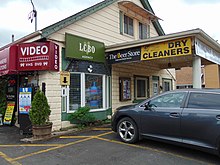Liquor Control Board of Ontario
[18] The Conservative government of George Howard Ferguson contested the 1926 provincial election on a platform of easing the temperance law.
Upon reelection, it introduced the Liquor Control Act as a compromise between the complete prohibition demanded by the temperance movement and the unregulated sale of alcohol.
Premier Ferguson stated that the Liquor Control Act was "... to allow people to exercise a God-given freedom under reasonable restrictions".
Ferguson was further quoted as saying the purpose of the LCBO was to "promote temperance sobriety, personal liberty and, above all, to restore respect for the law".
[19] To achieve these goals LCBO was mandated by Ferguson's government to employ an oversight mechanism in order to know "exactly who is buying and how much, and what disposition is being made of it".
Between 1927 and 1957, these permits came in the form of passport sized books that consisted of two separate sections, the first which included the permit holder's personal information (place of residence, marital status, occupation/employer, notes change of address) and a second section which kept a record of the individual's purchase history (date, quantity, value, store number and initials).
[28] This meant a store employee could deny a sale to a customer if his intended purchases may be considered too large for one person to reasonably consume.
[33] From 1927–1935, the LCBO's investigations resulted in the cancellation of over 33,138 liquor permits and the names of these individuals were added to the circulated interdiction list.
[34] In 1929, the LCBO's use of the interdiction list was expanded to include those on social assistance as well as others who the board felt should be prohibited from purchasing liquor permits entirely.
As part of the LCBO's regulations, licensed establishments were required to adhere to a wide variety of regulations including a limitation on singing, the number of patrons allowed to sit together and most importantly the segregation of female from unmarried male drinkers (women were only allowed to drink in the presence of a "bona fide escort" in a segregated "Ladies and Escorts" room).
[38] As of July 11, 2016, LCBO accepts tap-to-pay technology in each of their 654 stores in the province, allowing contactless payment for all purchases of liquor.
[41] In February 2025, the LCBO was ordered by Ontario premier Doug Ford to remove all sales of American alcohol in response to the Second Trump tariffs.
[42] After the federal government announced that recreational use of cannabis would be legalized in 2017 or early 2018,[43] then Premier Kathleen Wynne commented that the LCBO stores might be the ideal distribution network for stocking, controlling and selling such products.
The OCS logo, designed by a Canadian subsidiary of Leo Burnett Worldwide as part of a $650,000 marketing and branding contract,[51] was derided as "boring" and "underwhelming.
Under this new model OCRC will continue to operate the provincial online cannabis sales service and will serve as the wholesale supplier for private stores in Ontario.
Among its responsibilities are: The LCBO is accountable to its stakeholders in a number of ways, including: The board's policy states that "In Ontario's 25 designated areas, the operational signage in every LCBO store must be bilingual" ... "This type of signage includes stores' permanent signs and general notices, such as those in the aisles and for customer service.
Wines and spirits sold in Canada are subject to the Excise Act, 2001,[60] which contributes greatly to the cost of beverage alcohol, although most liquor tax is provincial.
[67] Former Premier Ernie Eves stated that when he investigated this possibility, he found that a 100 per cent sale through an income trust would generate 16 billion dollars.
[citation needed] In an attempt to find more revenue for the government within the current system, former Ontario Finance Minister Greg Sorbara ordered a review of the province's liquor distribution methods, under the supervision of John Lacey, a former LCBO board member and grocery executive.
Rejection of the findings notwithstanding, the 2005 report [69] defined the potential benefits of privatization alternatives as greater consumer convenience and choice via a competitive retail environment, a reduction in government-held investment risk while simultaneously increasing its annual revenues.
An earlier 1994 report from York University, created on behalf of the Ontario Liquor Boards Employees' Union, concluded there to be little governmental or public support for privatization.
Under the program, consumers may return empty bottles, tetra paks, PET plastic and bag-in-box containers, to The Beer Store outlets.
The deposit rates for the bottles are as follows: Through its Natural Heritage Fund, LCBO and its suppliers have raised almost $2 million for projects to restore and rehabilitate Ontario wildlife habitat.
In May 2011, a study[74] was conducted by Statopex Field Marketing on behalf of the Ontario Convenience Stores Association and found that the LCBO fared poorly when checking for age of minors.
The LCBO countered by stating its "retail staff challenged 3.6 million people who appeared underage or intoxicated in 2010 and refused to serve more than 190,000 customers.
The Cannabis Canada Association, a lobby group representing licensed medical marijuana growers, stated that "a competitive market model would provide the Province with a predictable, low-risk revenue stream without the taxpayer burdens of upfront capital expenditure exposure and operational risk".
[76] The debate proved to be merely of academic interest, since the newly-elected PC government decided in August 2018 that retail sales would be provided by private enterprise companies instead.
Finance Minister Vic Fedeli stated: "we will work with private sector businesses to build a safe, reliable retail system that will divert sales away from the illegal market.
"[77] In late 2018, two articles published by the Toronto Star indicated that theft from the LCBO retail stores was a significant problem, and effectively mishandled.






